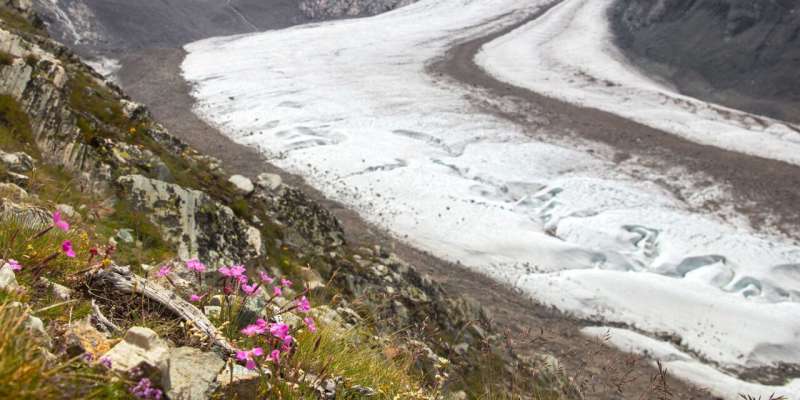Science
Ancient Gene Variants Help Alpine Plant Adapt to Climate Change

Research from ETH Zurich has uncovered how ancient gene variants in the wood pink, or Dianthus sylvestris, enable this Alpine plant to adapt to climate change. Published on November 3, 2025, the study highlights the plant’s unique genetic adaptations that allow it to thrive in the rapidly warming climate of the Alps.
The Alps are experiencing a notable increase in temperatures, challenging local flora and fauna. As organisms face the choice to migrate to higher altitudes or quickly adapt to their existing environments, the wood pink serves as a key example of successful adaptation. This perennial plant flourishes at altitudes ranging from 800 to 2,400 meters, and its flowering patterns vary significantly between high-altitude and lowland populations.
Researchers have documented that wood pinks in Alpine regions flower shortly after snowmelt in June, whereas their counterparts in the valleys begin blooming in May. This difference is attributed to the extended growing season in lower elevations, leading valley plants to adopt a later flowering strategy.
The investigation into these adaptations began a decade ago under the guidance of Simone Fior and Alex Widmer. Their recent findings focus on three valley populations and three mountain populations within the Swiss canton of Valais. They analyzed a specific gene across 1,000 individuals and conducted transplantation experiments to observe flowering behavior.
“Wood pinks in Alpine areas not only flower as early as possible but also produce seeds quickly,” Widmer explains. This adaptation is crucial for survival in the short growing season at higher altitudes. In contrast, valley plants, which have more extended growing seasons, tend to prioritize growth before flowering, requiring more time to mature and produce seeds.
The study identified the gene DsCEN/2, which governs flowering time and growth. Two variants of this gene, known as alleles, are present in different populations. The “warm” allele, found predominantly in valley populations, delays flowering to promote growth during longer, warmer summers. Conversely, the “cold” allele is associated with early flowering in Alpine environments.
According to Widmer, “Both alleles determine the wood pink’s survival in different climate zones.” The research team also discovered that these alleles are ancient and likely emerged long before the wood pink itself. By studying related species, they concluded that the alleles are remnants of a previous evolutionary radiation that occurred one to two million years ago, aligning with a time of significant climatic fluctuations.
The adaptations observed in the wood pink are a result of genetic reorganization mechanisms that allow plants to adapt more swiftly to changing environments. This process is crucial, particularly in instances of rapid diversification among species, such as those within the Dianthus genus. The presence of the warm and cold alleles provides a genetic foundation that enables the wood pink to adapt more readily than relying solely on new mutations.
As climate change progresses, these gene variants are expected to influence the wood pink’s response to rising temperatures. The warm allele has already been detected in high-elevation populations, suggesting that it may become increasingly dominant in the future. “The wood pink possesses tools from the past to adapt to climate change in the present,” Widmer notes.
Despite these genetic advantages, the ability of the wood pink and other Alpine plants to adapt quickly enough to current climate conditions remains uncertain. Widmer emphasizes that plants can only leverage their genetic potential if they exist in sufficiently large and interconnected populations. In contrast, small, isolated populations face a higher risk of extinction.
The findings from this research underscore the importance of understanding plant genetic adaptations in the context of climate change. Future studies will be critical to determine whether other Alpine plants possess similar genetic resilience and how they might respond to the challenges posed by a warming climate.
For further details, refer to the study titled “Ancient alleles drive contemporary climate adaptation in an alpine plant,” published in the journal Science.
-

 Technology4 months ago
Technology4 months agoDiscover the Top 10 Calorie Counting Apps of 2025
-

 Health2 months ago
Health2 months agoBella Hadid Shares Health Update After Treatment for Lyme Disease
-

 Health3 months ago
Health3 months agoErin Bates Shares Recovery Update Following Sepsis Complications
-

 Technology3 weeks ago
Technology3 weeks agoDiscover 2025’s Top GPUs for Exceptional 4K Gaming Performance
-

 Technology2 months ago
Technology2 months agoElectric Moto Influencer Surronster Arrested in Tijuana
-

 Technology4 months ago
Technology4 months agoDiscover How to Reverse Image Search Using ChatGPT Effortlessly
-

 Technology4 months ago
Technology4 months agoMeta Initiates $60B AI Data Center Expansion, Starting in Ohio
-

 Technology4 months ago
Technology4 months agoRecovering a Suspended TikTok Account: A Step-by-Step Guide
-

 Health4 months ago
Health4 months agoTested: Rab Firewall Mountain Jacket Survives Harsh Conditions
-

 Lifestyle4 months ago
Lifestyle4 months agoBelton Family Reunites After Daughter Survives Hill Country Floods
-

 Technology3 months ago
Technology3 months agoUncovering the Top Five Most Challenging Motorcycles to Ride
-

 Technology4 weeks ago
Technology4 weeks agoDiscover the Best Wireless Earbuds for Every Lifestyle



















